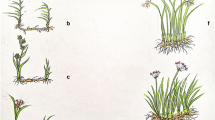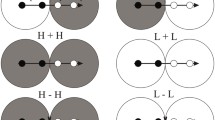Abstract
Physiological integration facilitates clonal plants to deal with heterogeneous resources. However, little is known about how nutrient patchiness affects its use and stoichiometry in clonal plants. We conducted an experiment with Cynodon dactylon, Glechoma longituba, and Potentilla reptans to address the effects of physiological integration on nutrient use efficiency and N:P ratios. For C. dactylon, the effects of nutrient patchiness on N use efficiency (NUE), P use efficiency (PUE), and N:P ratio were stronger in daughter ramets than in parent ramets; for G. longituba, nutrient patchiness affected PUE and N:P ratio of parent and daughter ramets, but not NUE; for P. reptans, nutrient patchiness decreased NUE, PUE, and N:P ratio, regardless of parent or daughter ramets. PUE was associated with N:P ratios in three clonal plants and this association of NUE with N:P ratios varied with species. Our findings suggest that physiological integration alters nutrient use efficiency and N:P ratios of clonal plants under patchy nutrients and that these effects are linked to clonal species identity.



Similar content being viewed by others
References
Aerts R, Chapin FS III (2000) The mineral nutrition of wild plants revisited: a re-evaluation of processes and patterns. Adv Ecol Res 30:1–67
Alpert P (1991) Nitrogen sharing among fragments increases clonal growth in Fragaria chiloensis. Ecology 72:69–80
Alpert P (1996) Nutrient sharing in natural clonal ramets of Fragaria chiloensis. J Ecol 84:395–406
Alpert P, Mooney HA (1986) Resource sharing among ramets in the clonal herb, Fragaria chiloensis. Oecologia 70:227–233
Caldwell MM, Pearcy RW (1994) Exploitation of environmental heterogeneity by plants. Academic Press, London
Cherif M, Loreau M (2007) Stoichiometric constraints on resource use, competitive interactions, and elemental cycling in microbial decomposers. Am Nat 169:709–724
Dietz H, Steilein T (2001) Ecological aspects of clonal growth in plants. Prog Bot 62:511–530
Editorial Board of Flora of China (1985) Flora of China, vol 37. Science Press, Bei**g, pp 330–331
Editorial Board of Flora of China (1990) Flora of China, vol 10. Science Press, Bei**g, pp 82–84
Elser JJ, Urabe J (1999) The stoichiometry of consumer-driven nutrient recycling: theory, observations, and consequences. Ecology 80:735–751
Elser JJ, Bracken MES, Cleland EE, Gruner DS, Harpole WS, Hillebrand H, Ngai JT, Seabloom EW, Shurin JB, Smith JE (2007) Global analysis of nitrogen and phosphorus limitation of primary producers in freshwater, marine and terrestrial ecosystems. Ecol Lett 10:1135–1142
Forde BG (2002) The role of long-distance signalling in plant responses to nitrate and other nutrients. J Exp Bot 53:39–43
Güsewell S (2004) N:P ratios in terrestrial plants: variation and functional significance. New Phytol 164:243–266
Güsewell S (2005) Nutrient resorption of wetland graminoids is related to the type of nutrient limitation. Funct Ecol 19:344–354
He W-M, Zhang H, Dong M (2004) Plasticity in fitness and fitness-related traits at ramet and genet levels in a tillering grass Panicum miliaceum under patchy soil nutrients. Plant Ecol 172:1–10
Hutchings MJ, Wijesinghe DK (1997) Patchy habitats, division of labour and growth dividends in clonal plants. TREE 12:390–394
Imsande J, Touraine B (1994) N demand and the regulation of nitrate uptake. Plant Physiol 105:3–7
Kay AD, Ashton IW, Gorokhova E, Kerkhoff AJ, Liess A, Litchman E (2005) Toward a stoichiometric framework for evolutionary biology. Oikos 109:6–17
Kolasa J, Pickett STA (1991) Ecological heterogeneity. Springer, Berlin
Lovelock CE, Feller IC, Ball MC, Ellis J, Sorrell B (2007) Testing the growth rate vs. geochemical hypothesis for latitudinal variation in plant nutrients. Ecol Lett 10:1154–1163
Price EAC, Hutchings MJ (1992) The causes and developmental effects of integration and independence between different parts of Glechoma hederacea clones. Oikos 63:376–386
Price EAC, Marshall C (1999) Clonal plants and environmental heterogeneity. Plant Ecol 141:3–7
Raghotama KG (1999) Phosphate acquisition. Annu Rev Plant Physiol Plant Mol Biol 50:665–693
Reich PB, Oleksyn J (2004) Global patterns of plant leaf N and P in relation to temperature and latitude. PNAS 101:11001–11006
Sterner RW, Elser JJ (2002) Ecological stoichiometry: the biology of elements from molecules to the biosphere. Princeton University Press, Princeton
Stuefer JF (1996) Potential and limitations of current concepts regarding the response of clonal plants to environmental heterogeneity. Vegetatio 127:55–70
Tournier B, Tabler M, Kalantidis K (2006) Phloem flow strongly influences the systematic spread of silencing in GFP Nicotiana benthamiana plants. Plant J 47:383–394
van Groenendael J, de Kroon H (1990) Clonal growth in plants: regulation and function. SPB Academic Publisher, The Hague
Wu Z, Chen J (1974) Materiae ad floram labiatarum sinensium (3). Acta Phytotax Sin xii:21–33
Acknowledgments
We are grateful to Giles C. Thelen at the University of Montana for his checking and polishing the language of this paper. This work was funded by grants from the National Natural Science Foundation of China (30770335 & 30870395).
Author information
Authors and Affiliations
Corresponding author
About this article
Cite this article
He, WM., Yu, FH. & Zhang, LL. Physiological integration impacts nutrient use and stoichiometry in three clonal plants under heterogeneous habitats. Ecol Res 25, 967–972 (2010). https://doi.org/10.1007/s11284-010-0724-0
Received:
Accepted:
Published:
Issue Date:
DOI: https://doi.org/10.1007/s11284-010-0724-0




